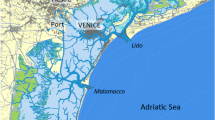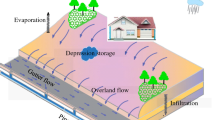Abstract
Based on the mechanism of landslide dam failure caused by overtopping, a simplified mathematical model for simulating dam breach overtopping flow processes was proposed in our previous work. The model is composed of five main modules including hydrodynamic, sediment transport and erosion, headward erosion, breach lateral evolution, and breach side slope stability. However, the breach lateral evolution module is still based on the assumption existing in most available models that breach lateral spreading is linearly related to the undercutting, i.e., the lateral erosion rate is twice as much as the vertical undercutting rate in the process of dam breaking. This assumption is obviously lack of theoretical basis. Through a theoretical analysis of sediment initial motion on the river channel slope, a lateral erosion formula was deduced in this paper. Then the lateral enlargement model was developed to update the breach evolution module in the previously established simulation model. To verify the effectiveness of the modification, A case study was conducted in the same overtopping failure event of Baige landslide dam, which was located at the border of Tibet Autonomous Region and Sichuan province in China, took place on November 3, 2018. A good model performance was achieved with predicted flood volume, peak discharge and occurrence time within 10% margin of error compared with field monitoring data. Furthermore, a comparing with the previous model was carried out and the results obtained by the modified model applying the new lateral enlargement formula proposed in this study indicate that the predicting accuracy of the model can be improved significantly for the simulation of landslide dam overtopping failure.















Similar content being viewed by others
References
Costa JE, Schuster RL (1988) The formation and failure of natural dams. Geol Soc Am Bull 100(7):1054–1068. https://doi.org/10.1130/0016-7606(1988)100<1054:TFAFON>2.3.CO;2
KongA FY, Deng HY, Tian SJ, Cun Y, JM (2010) Classification and typical case analysis of wenchuan earthquake-induced dammed lakes based on landslide formation mechanism. J Sichuan University 42(5):44–51. https://doi.org/10.15961/j.jsuese.2010.05.005
Wang GQ, Liu F, Fu XD (2008) Simulation of dam breach development for emergency treatment of the Tangjiashan Quake Lake in China. Sci China 51:82–94. https://doi.org/10.1007/s11431-008-6019-9
Ren Q, Chen SS, Zhong QM, Cao W (2011) Formation mechanism and breaching failure risk of barrier dams. Adv Sci Technol Water Resour 31(5):30–34. https://doi.org/10.3880/j.issn.1006-7647.2011.05.008
Wang GQ, Wang YQ, Liu L, Wang DY (2015) Reviewed on barrier dam and simulation on dam breach. Yellow River 37(9):1–7. https://doi.org/10.3969/j.issn.1000-1379.2015.09.001
Feng ZY, Huang HY, Chen SC (2020) Analysis of the characteristics of seismic and acoustic signals produced by a dam failure and slope erosion test. Landslides 17(7):1605–1618. https://doi.org/10.1007/s10346-020-01390-x
Cui P, Zhu YY, Han YS, Chen XQ, Liu HJ, Zhuang JQ (2009) The 12 may Wenchuan earthquake-induced landslide lakes: distribution and preliminary risk evaluation. Landslides 6(3):209–223. https://doi.org/10.1007/s10346-009-0160-9
Cui P, Chen XQ, Zhu YY, Su FH, Wei FQ, Han YS, Liu HJ, Zhuang JQ (2011) The Wenchuan earthquake (may 12, 2008), sichuan province, China and resulting geohazards. Nat Hazards 56(1):19–36. https://doi.org/10.1007/s11069-009-9392-1
Wang SJ (2018) Study on dam break calculation and life loss assessment of landslide dam. Xi’an University of Technology, China
Cai YJ, Cheng HY, Wu SF, Yang QG, Wang L, Luan YS, Chen ZY (2020) Breaches of the Baige Barrier Lake. emergency response and dam breach flood. Sci China-Technol Sci 63:1164–1176. https://doi.org/10.1007/s11431-019-1475-y
Chang DS, Zhang LM (2010) Simulation of the erosion process of landslide dams due to overtopping considering variations in soil erodibility along depth. Nat Hazard 10(4):933–946. https://doi.org/10.5194/nhess-10-933-2010
Fread DL (1984) DAMBRK: the NWS dam break flood forecasting model. National weather service (NWS) report, NOAA, Silver Spring
Fread DL (1988) BREACH: an erosion model for earthen dam failures. National weather service (NWS) report, MA NOAA, Silver Spring
Fread DL (1998) BREACH: NWS FLDWAV model. National weather service (NWS) report, M-A NOAA, Silver Spring
Singh VP, Quiroga CA (1988) Dimensionless analytical solutions for dam breach erosion. J Hydraul Res 26(2):179–197. https://doi.org/10.1080/00221688809499224
Zhong QM, Chen SS, Mei SA, Cao W (2017) Numerical simulation of landslide dam breaching due to overtopping. Landslides 15(6):1183–1192. https://doi.org/10.1007/s10346-017-0935-3
Chen ZY, Ma LQ, Yu S, Chen SJ, Zhou XB, Sun P, Li X (2015) Back analysis of the draini-ng process of the Tangjiashan barrier lake. J Hydraul Eng 141(4):05014011. https://doi.org/10.1061/(ASCE)HY.1943-7900.0000965
Zhang LM, Xiao T, He J, Chen C (2019) Erosion-based analysis of breaching of Baige landslide dams on the Jinsha River, China, in 2018. Landslides 16:1965–1979. https://doi.org/10.1007/s10346-019-01247-y
Zhong QM, Chen SS, Fu ZZ, Shan YB (2020) New empirical model for breaching of earth-rock dams. Nat Hazard Rev 21(2):06020002. https://doi.org/10.1061/(ASCE)NH.1527-6996.0000374
Zhong QM, Chen SS, Fu ZZ, Shan YB (2020) Numerical modeling of breaching process of Baige dammed lake on Jinsha River. Adv Eng Sci 52(2):29–37. https://doi.org/10.15961/j.jsuese.201900830
Zhong QM, Chen S, Wang L, Shan Y (2020) Back analysis of breaching process of Baige landslide dam. Landslides 17(7):1681–1692. https://doi.org/10.1007/s10346-020-01398-3
Li YL, Chen AK, Wen LF, Bu P, Li KP (2020) Numerical simulation of non-cohesive homogeneous dam breaching due to overtopping considering the seepage effect. Eur J Environ Civ Eng. https://doi.org/10.1080/19648189.2020.1744481
Shen G, Sheng J, Xiang Y, Zhong Q, Yang D (2020) Numerical modeling of overtopping-induced breach of landslide dams. Nat Hazard Rev 21(2):04020002. https://doi.org/10.1061/(ASCE)NH.1527-6996.0000362
Wu W (2013) Simplified Physically Based Model of Earthen Embankment Breaching. J Hydraul Eng 139(8):837–851. https://doi.org/10.1061/(ASCE)HY.1943-7900.0000741
Li JH, Huang E, Luo LH (2012) Experimental study on Influence factors for burst rate of Barrier Dams. Yellow River 34(8):8–11. https://doi.org/10.3969/j.issn.1000-1379.2012.08.003
Liu BX, Zhu XH, Guo J, Jiang C, Ma HA, PEI YH, (2020) Experiments research on breach broadening process of landslide dam under different channel bed slope. J Eng Geol 28(6):1272–1280. https://doi.org/10.13544/j.cnki.jeg.2019-514
Jiang XG, Cui P, Wang ZY, Heng WH (2016) Experiments investigation on longitudinal breaching of natural dam. J Sichuan Univ Eng Sci Edit 48(4):38–44. https://doi.org/10.15961/j.jsuese.2016.04.006
Zhao TL, Chen SS, Wang JJ, Zhong QM, Fu J (2019) Centrifugal model tests on the failure mechanism of barrier dam overtopping. KSCE J Civ Eng 23:1548–1559. https://doi.org/10.1007/s12205-019-0375-9
Wang XH (2000) Development and application of a numerical model for bank erosion and sediment transport in alluvial rivers. Xi’an University of Technology, China
Smart GM (1984) Sediment transport formula for steep channels. J Hydraul Div Am Soc Civil Eng 110(HY3):267–276. https://doi.org/10.1061/(ASCE)0733-9429(1984)110:3(267)
Jiang XG, Wu YW (2020) Erosion characteristics of outburst floods on channel beds under the conditions of different natural dam downstream slope angles. Landslides 17(8):1823–1834. https://doi.org/10.1007/s10346-020-01381-y
Shao XJ, Wang XK (2013) Introduction to river mechanics, 2nd edn. Tsinghua University Press, Beijing
Spangler MG (1951) Soil engineering. International Textbook Company, Scranton, Pennsylvania, pp 321–323
Cheng HY (2019) Hydrology emergency monitoring and forecast on"11·3"Baige barrier lake Jinsha River. Yangtze River 50(3):23–27. https://doi.org/10.16232/j.cnki.1001-4179.2019.03.005
Cai YJ, Luan YS, Yang QG, Xu FX, Zhang SJ, Shi Y, Yi DLZ (2019) Study on Structural morphology and dam-break characteristics of Baige barrier dam on Jinsha River. Yangtze River 50(3):15–22. https://doi.org/10.16232/j.cnki.1001-4179.2019.03.004
Chen ZY, Chen SS, Wang L, Zhong QM, Zhang Q, Jin SL (2020) Back analysis of the breach flood of the “11 03” Baige barrier lake at the Upper Jinsha River. Sci China Technol. https://doi.org/10.1360/SST-2019-0297
Xue RY, Zhang XH, Cai YJ, Wang M, Deng Q, Zhang H (2021) Numerical simulation of landslide dam overtopping failure considering headward erosion. J Hydrol. https://doi.org/10.1016/j.jhydrol.2021.126608
Osman AM, Thorne CR, Affiliate Member ASCE (1988) Riverbank stability analysis i: theory. J Hydraul Eng 114:134–150
Standard for hydrological information and hydrological forecasting, GB/T 22482–2008, National standards of the people's Republic of China, 2008. ISBN155066135646
Acknowledgements
This research was supported by the National Key Research and Development Program of China (Grant No. 2018YFC1505004) and the National Natural Science Foundation of China (Grant Nos. 51879174 and 51579162).
Author information
Authors and Affiliations
Corresponding author
Ethics declarations
Conflict of interest
We declare that we have no known competing financial interests or personal relationships that could influence the work reported in this paper.
Additional information
Publisher's Note
Springer Nature remains neutral with regard to jurisdictional claims in published maps and institutional affiliations.
Rights and permissions
About this article
Cite this article
Cai, Y., Zhang, X., Xue, R. et al. Numerical simulation of overtopping breach processes caused by failure of landslide dams. Environ Fluid Mech 22, 839–863 (2022). https://doi.org/10.1007/s10652-022-09858-1
Received:
Accepted:
Published:
Issue Date:
DOI: https://doi.org/10.1007/s10652-022-09858-1




